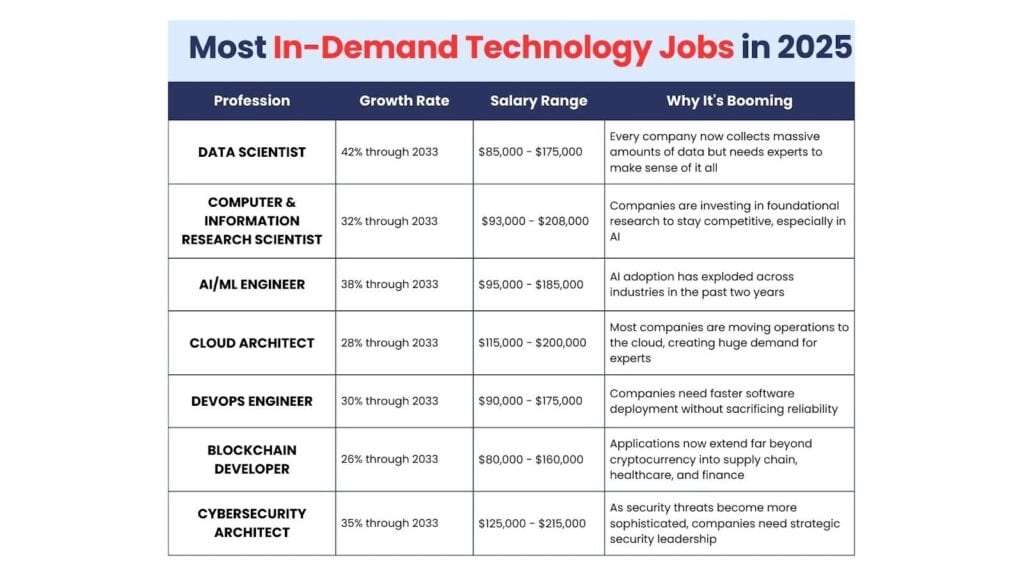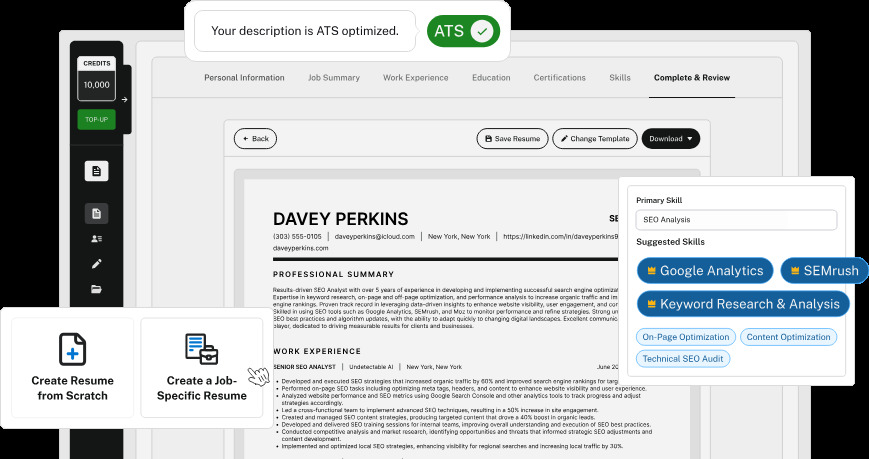“Another tech layoff?!”
It’s easy to sigh and toss your phone aside after seeing the fifth headline this week about some big tech company cutting jobs.
Parents of recent computer science graduates keep asking anxiously: “Should my child look at other industries? Is tech still a safe bet?”
Maybe you have had similar thoughts lately. Maybe you’re:
- A recent grad, questioning if those tech dreams are still worth pursuing.
- Working in retail or hospitality and eyeing tech’s higher salaries, but wondering if you’ve missed your chance.
- Already in tech but worried AI might eventually make your job obsolete.
All of the questions deserve answers based on facts.
This blog contains everything you need to understand the current tech job landscape.
We’ll discuss the actual employment numbers, salary data across different specializations, growth projects through 2033, and practical ways to break into the field. Whether you’re exploring coding bootcamps, tech certifications, or launching a freelance career, demand for skills like professional web development services continues to rise as businesses prioritize strong online presence and user experience.
The truth about tech jobs in 2025 is more nuanced—and far more promising—than what those alarming headlines suggest.
The State of the Technology Job Market
The tech industry is still one of the safest bets out there.
While the national unemployment rate sits at 4.1%, tech? just 2.6%.
In other words, tech workers are not only landing jobs faster but holding onto them longer than most people in other industries.


Never Worry About AI Detecting Your Texts Again. Undetectable AI Can Help You:
- Make your AI assisted writing appear human-like.
- Bypass all major AI detection tools with just one click.
- Use AI safely and confidently in school and work.
Yes, layoffs happened. A lot of them.
In 2024 alone, 451 companies cut over 139,000 jobs. On the surface, that sounds bad.
But here’s what most people miss…
Tech hiring hasn’t slowed down.
There are 211,000+ open tech positions.
This is a massive 29.5% jump from the low we saw in March 2023.
Since January, startups, unicorns, and public companies have opened 18% more jobs.
And it’s not just the big names.
While Meta, Amazon, and Google made headlines for layoffs, thousands of smaller tech companies have been hiring like never before.
Think about it – banks, hospitals, even factories – when they need to upgrade their systems, who do they call? Tech workers.
That’s why tech jobs bounce back fast. One door closes, and a dozen more open.
Growth of the Tech Industry & Job Demand
Jobs in the U.S. technology sector are increasing at twice the rate of jobs across other sectors.
The growth is not because of the tech companies.
Less than half (45%) of all tech workers work at traditional tech companies.
The other (55%) work at regular businesses – banks, hospitals, factories, stores, and government offices,
This is happening because of three big reasons:
- Every company is now a new company. “Digital transformation” is in full swing. Even your local grocery store chain needs software developers and IT specialists, and custom software development services to meet evolving consumer and operational demands.”
- Hackers are attacking businesses every day. That’s why cyber security experts are in huge demand everywhere.
- Data is the new gold. Businesses are drowning in information and need data analysts and scientists to turn it into something meaningful.
What’s interesting is how tech jobs are spreading across the country.
Silicon Valley is not the only place hiring.
In October 2024, for example:
- Washington D.C. had over 16,150 tech job postings.
- New York was closed behind 13,386 openings.
- Dallas had about 10,011.
- Cities like Austin, Denver, Atlanta, and Raleigh are becoming major tech hubs too, often with lower living costs than California.
How AI & Automation Impact Tech Job Availability
At this point, everyone is afraid of AI.
However, the truth is much more complex—and far more optimistic.
Job titles such as “prompt engineer,” “AI ethics specialist,” and “machine learning operations manager” have emerged only over the past five years.
Now, they are some of the fastest-growing positions in the tech world.
Elle Farrell-Kingsley, a tech presenter and advisor at the Arizona College of Technology stated,
“In the last six months, there’s been a gradual recovery, particularly in fields such as AI, cybersecurity, and cloud computing, which have seen a surge in demand,”
AI and automation are changing how we operate.
Certain jobs have become so simplified that they can be done with a push of a button instead of taking an extensive period.
In comparison to the previous year, the United States is expected to have 32% more AI-related positions in 2024.
That’s over 10,000 new positions available in the country.
And these positions are not solely concentrated in large tech firms.
- AI experts are needed in banks for fraud detection.
- There is a need for the analysis of medical data in hospitals.
- Even farms are employing AI for crop monitoring and harvest prediction.
Most tech professionals aren’t getting cut from their jobs.
Instead, they are getting their positions made easier with the integration of AI.
The robotic tasks within their work are now automated.
Consider this: spell-check did not remove writers from the workforce – rather, it enhanced the productivity of writers.
Just like with AI proficiency tools, programmers and analysts are not being replaced.
They now can work faster because they are given bigger problems to solve.
There is another important point to consider: AI systems rely on human supervision.
They are prone to making errors. They have bias. Unlike humans, they cannot comprehend context.
This opens up completely new categories of roles dedicated to monitoring, enhancing, and supervising AI systems. Looking globally, the rise of AI is also creating a shift in how we define opportunity. A recent report by ThePayStubs shows that while automation may transform certain repetitive roles, it’s also accelerating demand for new, tech-enabled careers across industries. From agriculture to finance, professionals who embrace AI tools and upskill accordingly are better positioned than ever to thrive in the evolving workforce.
Projected Growth of Technology Jobs in 2025 & Beyond
The Bureau of Labor Statistics (BLS) shows that the tech sector continuing its strong growth trajectory.
Employment in professional, scientific, and technical services is set to jump by more than 10% between 2023 and 2033.
That’s significantly faster than the average for all other industries combined.
But not all tech jobs will grow at the same pace.
If you’re considering which tech path to pursue, pay close attention to these high-growth areas:
- Data scientists are leading the pack with a projected 42% growth rate.
- Close behind are information security analysts, expected to grow by 41%.
- Computer and information research scientists aren’t far behind with a projected 32% growth rate.
Beyond these established fields, emerging technologies are creating entirely new job categories.
Quantum computing specialists are increasingly sought after as companies like IBM, Google, and Microsoft race to develop practical quantum computers.
Blockchain developers continue to find opportunities beyond cryptocurrency as industries from healthcare to supply chain management explore the technology’s potential.
How Many Jobs Are Available in Technology?
If your question is how many tech jobs are out there right now, so the two-word answer is: A LOT.
In October 2024, there were 528,402 active job postings for tech positions across major boards like LinkedIn, Indeed, and Dice.
That’s over half a million chances to start or advance the career.
And unlike a few years ago when most tech jobs were in-office, today you’ll find a healthy mix of remote, hybrid, and in-office opportunities to match the preferred working style.
Current Employment Statistics in the Tech Industry
The tech workforce is already massive and getting bigger by the day.
About 6 million people are working in tech jobs across America.
This number is expected to reach 7.1 million by the year 2034.
The tech industry is indeed growing, but it’s also struggling with diversity.
Women make up a small portion of the tech workforce. Black and Hispanic workers remain underrepresented compared to their presence in the overall workforce.
Job Growth Predictions Over the Next 5-10 Years
Tech is growing fast.
Several factors can speed up this growth even more, including government investments in technology infrastructure, accelerated AI adoption, and increased cybersecurity needs.
On the flip side, prolonged economic downturns or significant changes in immigration policies affecting skilled tech workers could temporarily slow growth.
Looking internationally, countries like India, Canada, and several European nations are seeing similar or even faster tech job growth.
However, the U.S. remains a global leader in creating new, innovative tech positions.
Why Technology Careers Are Among the Most In-Demand
Tech jobs are also remarkably stable.
Reason # 1 – During recent economic uncertainty, when many industries saw layoffs and hiring freezes, the tech unemployment rate stayed at just 2.6%, far below the national average.
People saw the tech field as the long-term security.
Reason # 2 – Another major advantage is that tech skills are needed everywhere. Hospitals, banks, government agencies – every modern organization needs technology professionals.
This means you’re never limited to just one sector for the job opportunities.
Reason # 3 – Perhaps most appealing for many people is the salary premium that comes with tech jobs.
The median salary for tech occupations was estimated at $104,556 in 2024 — more than double the median wage across all occupations.
Even entry-level tech positions typically offer competitive pay compared to other fields.
Reason # 4 – Finally, tech jobs continue to lead the way in workplace flexibility.
Remote and hybrid options remain more common in tech than in most other career fields, giving tech workers more control over their work environment and better work-life balance.
Most In-Demand Technology Jobs (With Salaries & Growth Rate)
Wondering which tech jobs offer the best opportunities right now?
Here are the seven hottest tech careers based on growth rates, salary potential, and hiring demand:

If you’re seeking an entry-level position with the strongest growth paths, choose junior data analysts, cloud support specialists, and AI operations technicians.
These roles often require less experience but provide valuable stepping stones to the higher-paying positions listed above.
What Sectors Have the Most Technology Jobs?
Tech jobs aren’t just in Silicon Valley anymore. In fact, nearly 55% of all tech professionals now work outside traditional tech companies.
So, where are all these jobs hiding? Let’s break it down:
1. Financial Services
Banks have quietly become some of the biggest tech employers in the world. If you’ve ever used a mobile banking app, you’ve seen this shift in action.
- JPMorgan Chase employs more software developers than many major tech firms.
- Insurance companies, fintech startups, and investment firms are hiring aggressively for AI, risk modeling, and cybersecurity roles.
- Payment platforms, fraud detection systems, and automated trading? All built by tech workers.
2. Healthcare
Tech is completely transforming healthcare, and the demand for skilled workers is skyrocketing.
- Electronic health records, AI-driven diagnostics, and telemedicine platforms are just the beginning.
- The pandemic sped up years’ worth of digital health innovation, and that momentum hasn’t slowed.
- Healthcare companies need developers, data scientists, and cybersecurity experts who understand the industry’s unique challenges.
3. Manufacturing
Modern manufacturing is all about automation, robotics, and smart systems.
- Companies like GE, Ford, and 3M are hiring software engineers and data scientists to power “smart factories.”
- IoT sensors, AI-driven logistics, and digital twins (virtual replicas of physical systems) are revolutionizing production.
4. Government & Public Sector
Government IT used to be slow and outdated. Not anymore.
- Organizations like the U.S. Digital Service and 18F are hiring top tech talent to fix broken systems.
- Cybersecurity roles in government are in huge demand, especially with rising digital threats.
So now the question is: Should you work at a startup or a big company? It depends on what you want:
- Startups = Fast-paced, more risk, potential for big equity payoffs.
- Big Companies = Stability, benefits, and structured career growth.
Many tech professionals switch between both during their careers—each offers different learning experiences.
What all this means for you is simple: your tech skills can take you almost anywhere.
The days of tech workers being confined to tech companies are long gone.
Your coding, data, or cybersecurity skills are now your ticket to virtually any industry that interests you.
How to Get a Job in Technology
Forget the idea that you need a degree to break into tech.
Whether you’re self-taught, a boot camp grad, or going the traditional route, there’s a path for you.
Here’s how to land a job in technology.
1. Choose Your Path
- Degree Holders – Focus on internships, networking, and building real-world experience.
- Self-Taught – Build projects, contribute to open-source, and get hands-on.
- Bootcamp Grads – Highlight practical skills, collaborate on projects, and showcase problem-solving abilities.
2. Build a Strong Resume
Hiring managers scan resumes in seconds—so yours needs to pop.
Our AI Resume Builder helps you craft a standout resume in minutes, making sure you highlight the right skills and experience.
If you’re using AI tools to help draft your resume or cover letter, consider refining the tone with Humanize AI.
It adjusts robotic or overly generic language into clear, natural phrasing that reads more like you—improving engagement while preserving professionalism.
A polished, human-sounding application can make a stronger impression with hiring managers.

3. Build a Portfolio
Having a portfolio is like having proof of your skills. Include:
✔️ Personal projects
✔️ Open-source contributions
✔️ Case studies of problems you solved
4. Apply Smarter, Not Harder
Instead of spending hours applying manually, use our Smart Applier to speed up the process.
It finds the best jobs for your skills and submits applications for you.
More applications = more chances to land interviews.
5. Test Your SkillsBefore applying, take a skills assessment to know where you stand. Sites like LeetCode, HackerRank, and Coursera offer great practice.
Don’t forget to explore our AI Detector and Humanizer in the widget below!
FAQs About Tech Job Availability
How Many Jobs Are Available in Technology?
As of early 2025, the U.S. job market offers roughly 211,000 open positions in tech, with 667,000 new tech jobs expected by 2030.
What Are the Fastest-Growing Tech Jobs?
AI Specialists/ML Engineers(35%) annually, Cybersecurity Analysts(33%), Cloud Infrastructure Engineers (25%), Data Scientists (22%), and DevOps Engineers (21%).
Do You Need a Degree for a High-Paying Tech Job?
Not really. Top companies prioritize skills over degrees. However, advanced AI, security, and research roles often require one.
What Tech Jobs Pay the Most?
CTOs ($185K-$300K+), AI/ML Research Scientists ($150K-$250K), Cloud Architects ($140K-$200K), Cybersecurity Directors ($135K-$190K), and Data Science Managers ($130K-$180K).
Conclusion
So, are you still worried about those layoff headlines?
Take a step back. 211,000 open jobs. Tech unemployment at just 2.6%.
Does that really sound like an industry on the decline?
What if instead of shrinking, tech is actually gearing up for its next big wave?
What if right now – while the headlines scream layoffs – you’re missing out on a field that’s set to create a million new jobs over the next decade?
Some of the best opportunities out there don’t even require a fancy degree.
Think back. People once thought computers were a nice hobby. That smartphones were necessary.
That social media was just a fad. Tech does not stop. It evolves. It expands. It finds new ways to surprise us.
So maybe, the real question isn’t “Are there enough tech jobs,” but rather “Which tech path is right for ME?”
One thing is clear: Tech is not going anywhere.
It needs people. It needs YOU.
